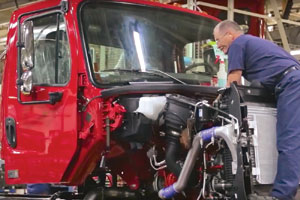Senior Reporter
May Truck Orders Plunge 30%; OEMs Plan Additional Cutbacks

This story appears in the June 13 print edition of Transport Topics.
Class 8 truck orders in May plunged 30% year-over-year, two research firms said, underscoring two truck manufacturers’ recently announced plans to trim production for the second time this year.
Daimler Trucks North America, a unit of Daimler AG, plans to cut 1,240 jobs across a number of production facilities starting in late June as it anticipates a 15% decrease in retail sales of Classes 6-8 vehicles from the 425,000 units last year.
Earlier this month, Volvo Trucks North America, a unit of the Volvo Group, announced production cuts at its Dublin, Virginia, plant in “the early August timeframe,” given the continued decline in Class 8 orders.
ACT Research Co. reported May’s orders fell 30% to 14,300 compared with 20,533 a year earlier, citing preliminary data. The company said it will publish final numbers for May in mid-June.
May registered the second- lowest order volume since July 2012, when orders totaled 12,925, according to ACT. Only April’s total of 13,676 was lower over that same period.
Research firm FTR also said May’s heavy-duty orders fell 30% to 14,100.
“DTNA’s workforce adjustments are in response to a sustained reduction in orders and a diminished build rate, and are expected to be temporary,” the company said in an e-mailed statement to Transport Topics.
The Portland, Oregon-based truck maker said the reductions include about 600 workers at its facility in Mount Holly, North Carolina; 270 workers in Santiago, Mexico; 200 at its components and logistics facility in Gastonia, North Carolina; and 170 workers at the Western Star plant in Portland. DTNA also said there currently are no plans to reduce the workforce at facilities in Cleveland, North Carolina, or Saltillo, Mexico.
The company announced an initial round of cuts in January at its Cleveland, North Carolina, plant.
VTNA spokesman John Mies told TT on June 1, “It’s by now very clear that the industry is managing through a period of excess inventory and reduced demand. And we’re seeing that softening particularly in the longhaul segment, which is core for Volvo Trucks. This, unfortunately, means that we will have to lay off employees, but it’s too soon to say how many people or exactly when.”
VTNA announced in January it expected to layoff about 730 people in February. “It turned out that number was about 500,” Mies said.
Other truck manufacturers were unavailable for comment. Efforts to reach the United Auto Workers union were unsuccessful.
Steve Tam, vice president of ACT’s commercial sector, said the industrywide decline in orders was “closely aligned” to the weak manufacturing and energy sectors of the economy.
“If you look at the pullback in global commodities, really, I think that is what’s driving the slowdown in manufacturing and in freight,” he said. “On the Class 8 side, trucks tend to be more about the producer side of the ledger than the consumer side.”
Added FTR Chief Operating Officer Jonathan Starks, “This is a pretty standard soft market. I conjecture that it just feels different this time because we haven’t had a typical midrecovery swoon since the mid-’90s. In the mid-2000s, it was complicated by the engine mandate followed by the biggest recession in at least three decades.”
Upcoming mandates, however, may even help buoy or possibly stimulate the market, Starks said.
FTR looks for truck production numbers to stabilize and rebound next year.
“The market should be set for, at minimum, a continuation of the current market with solid chances for a production increase — a small increase, but enough to satisfy the markets,” Starks said.
“Dealer inventories of Class 8 trucks remain bloated, so the only truck orders now are mainly for replacement purposes, with preferred specifications,” Don Ake, FTR vice president of commercial vehicles, said in a statement. “Backlogs will continue to fall; they are now below 2014 levels for May.”
The past three months of Class 8 order activity annualizes to 175,000 units, compared with the past 12 months at 231,000 units, according to FTR.
Ake said soft orders were expected. “The good news is that they did not fall further from April, but some erosion in order activity is expected during the slow summer months.”
Ann Duignan, an analyst with JP Morgan, noted that while “macroindicators” for truck purchases are mixed, the market is expected to recover in 2017 as capacity tightens.
She cited the Institute for Supply Management New Orders Index, which came in at 55.7 in May and marked the fifth consecutive reading above 50.
That’s “down from 55.8 last month but up 0.2% year-over-year, the third straight month of year-over-year expansion implying a potential increase in freight six to nine months from now,” Duignan wrote June 2 in a note to investors.


